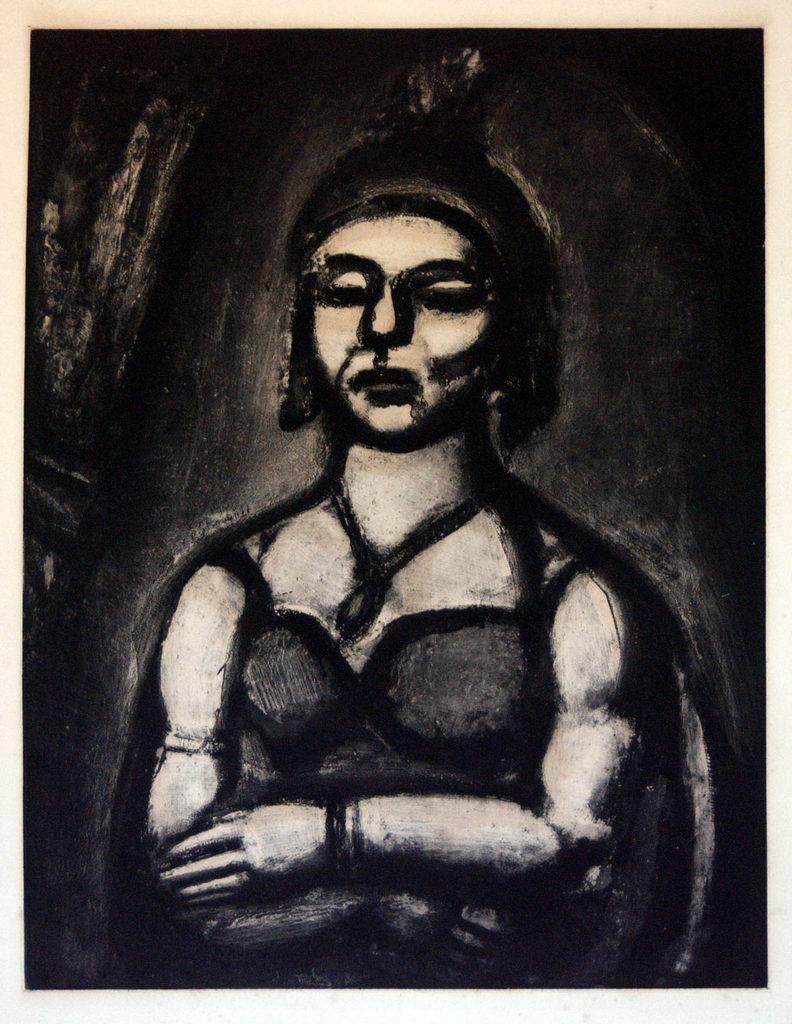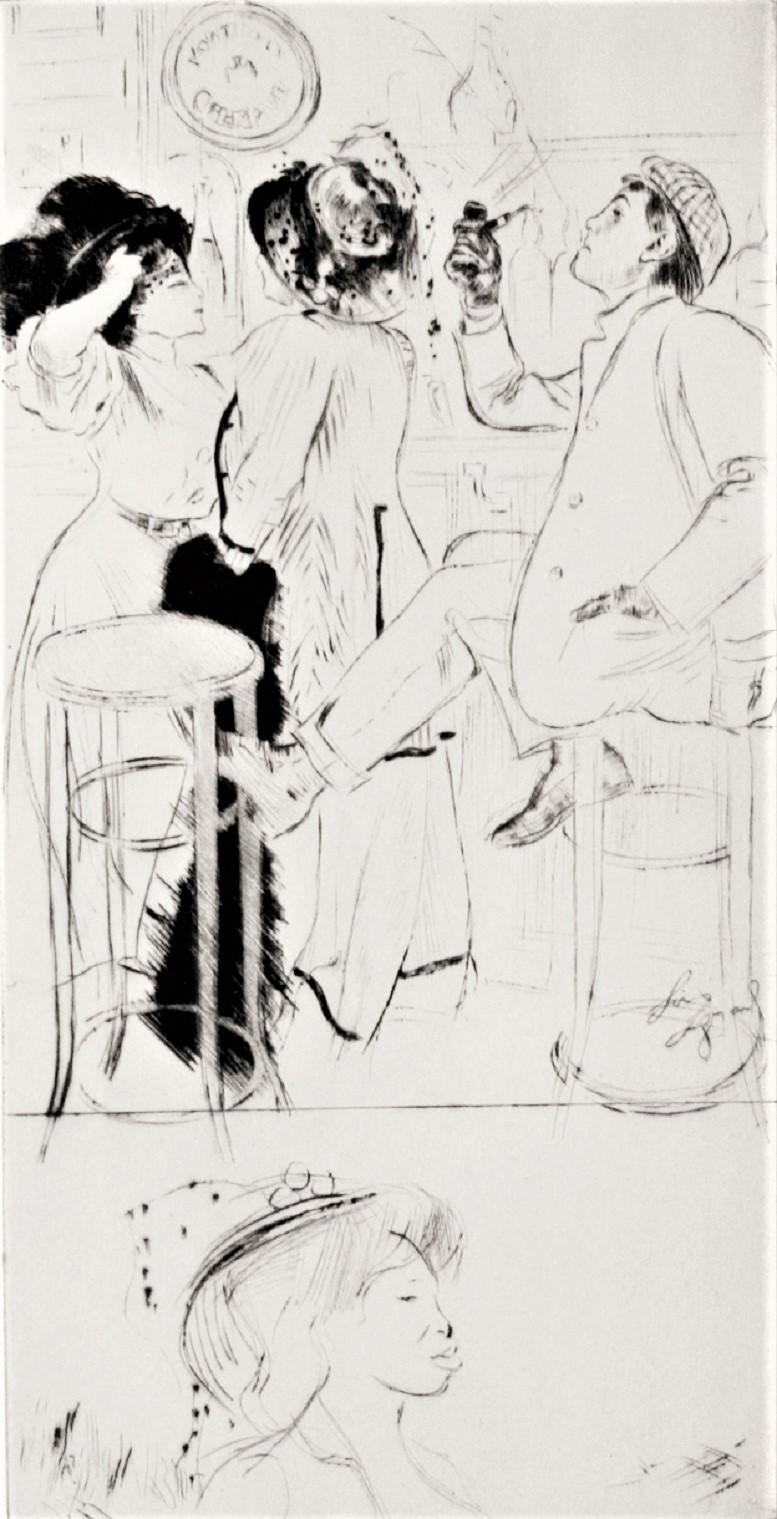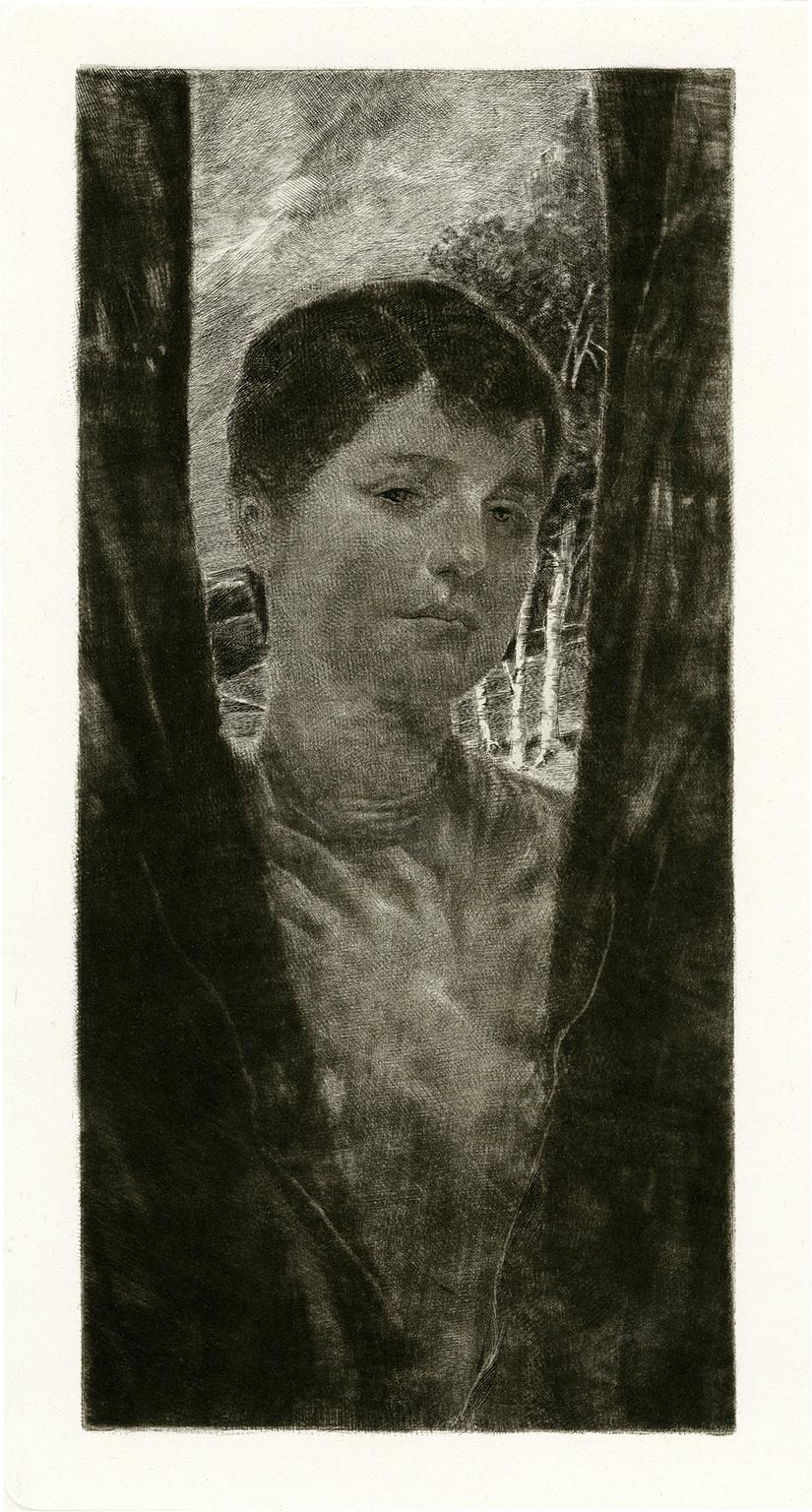Orovida PissarroChatter by Orovida Pissarro - Etching1927
1927
About the Item
- Creator:Orovida Pissarro (1893 - 1968)
- Creation Year:1927
- Dimensions:Height: 10.24 in (26 cm)Width: 7.49 in (19 cm)
- Medium:
- Movement & Style:
- Period:
- Condition:
- Gallery Location:London, GB
- Reference Number:1stDibs: LU261211850202
Orovida Pissarro
Orovida Pissarro, the only child of Lucien and Esther Pissarro, was the first woman in the Pissarro family to become a professional artist and the first Pissarro of her generation to take up painting. Born in Epping, England, in 1893, she lived and worked predominantly in London, where she was a prominent member of several British arts clubs and societies.
Orovida first learned to paint in the Impressionist style from her father and, after a brief period of formal study with Walter Sickert in 1913, she renounced formal art schooling.
Throughout her career, Orovida always remained outside mainstream British art movements. Much to Lucien's disappointment, she soon turned away from naturalistic painting and developed an unusual style that combined elements of Japanese, Chinese, Persian and Indian art. Her rejection of Impressionism, which, for the Pissarro family, was a way of life, and her simultaneous decision to drop her famous last name and use simply Orovida as a nom de peintre, reflected a desire for independence and distance from the family legacy, of which she nevertheless remained proud.
Orovida's most distinctive works are her paintings from the 1920s and 1930s in gouache (she called her mixture body color) and tempera, applied in thin, delicate washes to silk, linen, paper or gold leaf and embellished with brocade borders. These elegant and richly decorative works generally depict non-Western subjects, for example: Mongolian horseback riders, African dancers and Persian princes, often engaged in activities such as dancing or hunting rituals.
The second half of Orovida's painting career is marked by a dramatic change in both style and subject matter. In the mid-1940s, she began to embrace contemporary subjects from everyday life and returned to a more naturalistic style. Her new style was more suited to oils, and thus, she returned to that medium.
Over the course of her life, Orovida was aware of the mixed blessing of having famous artists in the family; not only a grandfather and father but also four uncles, and towards the end of her life, she was instrumental in developing the Pissarro family archive that her mother had established at the Ashmolean Museum in Oxford.
(Biography provided by Stern Pissarro Gallery)
- ShippingRetrieving quote...Ships From: London, United Kingdom
- Return PolicyA return for this item may be initiated within 7 days of delivery.
- Charlotte and Amalia by Lélia Pissarro - EtchingBy Lelia PissarroLocated in London, GBCharlotte and Amalia by Lélia Pissarro (b. 1963) Etching 22.7 x 27.5 cm (9 x 10 ⁷/₈ inches) Signed lower left, Lélia Pissarro Numbered lower right, 2/15 Artist biography: Born in P...Category
1990s Post-Impressionist Figurative Prints
MaterialsEtching
- Horse Pulling Hay Cart by Félix Pissarro - Animal etchingBy Félix PissarroLocated in London, GBHorse Pulling Hay Cart by Félix Pissarro (1874-1897) Etching 19.5 x 15 cm (7 ⅝ x 5 ⅞ inches) Exhibition London, Stern Pissarro Gallery, Camille Pissarro & hi...Category
1890s Post-Impressionist Animal Prints
MaterialsEtching
- Rupert Rides by Orovida Pissarro - Animal etchingBy Orovida PissarroLocated in London, GB*UK BUYERS WILL PAY AN ADDITIONAL 20% VAT ON TOP OF THE ABOVE PRICE Rupert Rides by Orovida Pissarro (1893-1968) Etching 31 x 23.5 cm (12 ¼ x 9 ¼ inches) Signed and dated lower righ...Category
1950s Post-Impressionist Animal Prints
MaterialsEtching
- Curves by Orovida Pissarro, 1919 - Etching PrintBy Orovida PissarroLocated in London, GBCurves by Orovida Pissarro (1893 - 1968) Etching, trial proof no. 54 20.2 x 15 cm (8 x 5 ⅞ inches) Signed and dated lower right, Orovida 1919 Inscribed lower left Trial proof no. 54 ...Category
1910s Post-Impressionist Animal Prints
MaterialsPaper, Etching
- Man & Beast by Orovida Pissarro - EtchingBy Orovida PissarroLocated in London, GB*UK BUYERS WILL PAY AN ADDITIONAL 20% VAT ON TOP OF THE ABOVE PRICE Man & Beast by Orovida Pissarro (1893-1968) Etching 27 x 22 cm (10 ⁵/₈ x 8 ⁵/₈ inches) Signed and dated lower right, orovida 1924 Inscribed lower left, Final state no 12/40 and titled lower centre Artist biography: Orovida Camille Pissarro, Lucien and Esther Pissarro’s only child, was the first woman in the Pissarro family as well as the first of her generation to become an artist. Born in Epping, England in 1893, she lived and worked predominantly in London where she became a prominent member of several British arts clubs and societies. She first learned to paint in the Impressionist style of her father, but after a brief period of formal study with Walter Sickert in 1913 she renounced formal art schooling. Throughout her career, Orovida always remained outside of any mainstream British art movements. Much to Lucien's disappointment she soon turned away from naturalistic painting and developed her own unusual style combining elements of Japanese, Chinese, Persian and Indian art. Her rejection of Impressionism, which for the Pissarro family had become a way of life, together with the simultaneous decision to drop her famous last name and simply use Orovida as a ‘nom de peintre’, reflected a deep desire for independence and distance from the weight of the family legacy. Orovida's most distinctive and notable works were produced from the period of 1919 to 1939 using her own homemade egg tempera applied in thin, delicate washes to silk, linen or paper and sometimes embellished with brocade borders. These elegant and richly decorative works generally depict Eastern, Asian and African subjects, such as Mongolian horse...Category
1920s Post-Impressionist Animal Prints
MaterialsEtching
- Les Poules de Lyora by Lélia Pissarro - Etching and watercolour on paperBy Lelia PissarroLocated in London, GBLes Poules de Lyora by Lélia Pissarro (b. 1963) Drypoint and watercolour on paper 21.5 x 26.5 cm (8 ¹/₂ x 10 ³/₈ inches) Signed lower left, Lélia Pissarro Numbered lower right, 10/15...Category
21st Century and Contemporary Post-Impressionist Figurative Prints
MaterialsPaper, Watercolor, Drypoint
- Des Ongles Et Du BecBy Georges RouaultLocated in Roma, ITEdition of 450 prints, belonging to the suite “Miserere”, considered as the most important religious graphic work of XX century. The single prints, realized with a sophisticated mixe...Category
1940s Post-Impressionist Figurative Prints
MaterialsEtching
- Au Bois de Boulogne - Original Etching by H. Farge - Mid 20th CenturyLocated in Roma, ITImage dimensions: 16 x 11 cm. Au Bois de Boulogne is an original modern artwork realized in the first decades of the XX Century by the French artist Henri Farge...Category
Mid-20th Century Post-Impressionist Figurative Prints
MaterialsEtching
- L’Ane - Original Etching and Aquatint by G. Rouault - 1927By Georges RouaultLocated in Roma, ITL’Ane is an original lithograph, realized by Georges Rouault in 1927, hand signed, Ambroise Vollard's stamp, trial proof of the first state, printed in 10 copies. Included a frame. In very good conditions. The artwork demonstrates a man-donkey creature dressed in suit formally and with a glasses. Georges Henri Rouault (1871-1958) was a French painter, print-maker artist, his artworks are often associated with Fauvism and Expressionism. He is well-known for paintings dedicated to courts, clowns and prostitutes. He was inspired by spirituality and knowledge of medieval stained glass...Category
1920s Post-Impressionist Figurative Prints
MaterialsAquatint, Etching
- SportsmenBy Louis LegrandLocated in Storrs, CTSportsmen. 1908. Etching and drypoint. Exsteens 271.i/ii. 11 1/4 x 5 3/4 (sheet 17 3/8 x 12 1/4). Series: Les Bars. From the first state edition of 30 proofs with the remarque sketch...Category
Early 1900s Post-Impressionist Figurative Prints
MaterialsDrypoint, Etching
- Erinnerung (Remembrance) — Turn-of-the Century Romantic EtchingBy Max KlingerLocated in Myrtle Beach, SCMax Klinger, 'Erinnerung (Remembrance)', etching and aquatint, 1896. A fine, richly inked impression, on off white, wove paper, with full margins (1 3/4 to 3 1/8 inches), in excellen...Category
1890s Post-Impressionist Figurative Prints
MaterialsAquatint, Etching
- Working - Original Etching by A. Delasalle - Mid-20th CenturyBy Angèle DelasalleLocated in Roma, ITWorking is a contemporary artwork realized by the French artist Angèle Delasalle in the Mid-20th Century. Original etching and drypoint. Signed and ...Category
Mid-20th Century Post-Impressionist Figurative Prints
MaterialsEtching






